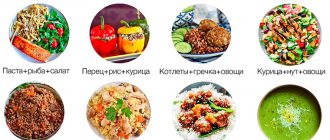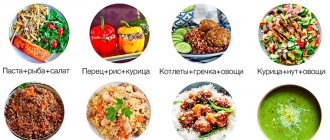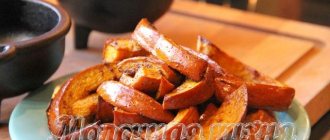- Previous
- Next
25.05.2016
Low in calories does not mean tasteless and nutrient poor. Stock your refrigerator with healthy, low-calorie foods that promote health and weight loss!
Posted by Matthew Cady, MS, Registered Dietitian
Although zero-calorie donuts have not yet been invented, this does not mean that the search for healthy and nutritious foods for a low-calorie diet is doomed to failure. Don't fill your stomach with food waste. Think about all the extra exercise you'll have to do to burn off the calories of an entire pizza or tall glass of chocolate ice cream.
Choosing the right low-calorie foods will help you tip the scales toward burning fat rather than storing it. To help you get started, we've ranked the top 40 products from different departments of the supermarket.
There is a myth that some foods have “negative” calories, meaning they require more energy to digest than they contain. This isn't true, but the supermarket and farmers' markets are full of healthy, low-calorie foods that have little impact on your energy intake. In fact, 35 of the 40 foods listed here contain 100 calories or less per serving!
If you carefully calculate the caloric content of the menu in order to get rid of inches on your waist, it is very important to fill your diet with food that does not leave you feeling hungry. After all, you don't want to go hungry all day.
Good news for your muscles and taste buds. Not all low-calorie foods are raw vegetables for salads. The meat, dairy and other departments of the supermarket are a generous haven for excellent food, which, despite its low calorie content, is loaded to the brim with benefits like protein and bright taste.
If you want to munch on something but are worried about taking on too many calories, these supplies will help you get the most without the risk of going over the limit.
Vegetables
Watercress
4 calories in 1 cup
Your menu needs this low-calorie vegetable. A study by the Center for Disease Control and Prevention found that among all supermarket products, watercress stands out as having the highest nutritional content. Simply put, tiny green leaves give you a giant dose of nutrients. And, like other cruciferous vegetables, watercress is a powerful antioxidant.
Like other cruciferous vegetables, watercress is a powerful antioxidant.
Advice
Heat olive oil in a large saucepan over medium heat. Cut 3 pears and 1 white potato into slices and place them in the pan. Add 1 tablespoon grated ginger. Keep on fire for 2 minutes. Pour in 4 cups of vegetable broth, add ½ teaspoon salt and ¼ teaspoon black pepper. Bring to a boil, turn down the heat and simmer covered for 20 minutes.
Add 2 bunches of watercress, 2 tablespoons of red vinegar and 2 tablespoons of fresh tarragon. Keep on fire for 5 minutes, squeeze out the juice of half a lemon and make a puree soup out of it all. Then pour 1 cup of unsweetened almond milk into the pan and cook for a couple more minutes.
Arugula
5 calories per cup
A bunch of tangy greens make a great salad or sandwich topper with very little calories. Arugula makes up for its calorie deficit with a high dose of vitamin K. In addition, like other leafy vegetables, arugula is a powerful antioxidant. Look for it near green vegetables, such as baby spinach.
Advice
To make a quick sandwich, toast a couple of thin slices of bread in the toaster. Spread one with Dijon mustard, top with thin strips of ham, apple slices and a bunch of arugula. Press the whole thing down with the second slice.
Celery
6 calories per stem
Celery may not have achieved the superfood status that made kale a favorite among skinny-jean fans, but it makes a cool crunchy addition to a low-calorie diet. Celery is an incredibly bulky food, meaning you can eat your fill without going overboard on calories.
Celery is an incredibly bulky food, meaning you can eat your fill without going overboard on calories.
With just a few calories, you'll get a hefty dose of vitamin K, an essential nutrient that reduces the risk of death from heart disease.
Advice
Make a hearty chicken noodle soup. In a large saucepan, heat the oil over medium heat. Chop the carrots, onions and celery and place them in a saucepan. Cook until the onion is soft. Add 4 cups chicken broth, ½ teaspoon salt, ¼ teaspoon black pepper and ¼ teaspoon chili flakes. Cook until the vegetables are tender, then add the shredded cooked chicken, cooked soba noodles and fresh thyme.
Pak choy (Chinese cabbage)
9 calories in 5 leaves
Although kale and spinach get all the glory, this vegetable from Asia is worth including in a calorie-restricted diet. A member of the cruciferous family, it is rich in nutrients, especially vitamins C, A and antioxidants. It has a milder flavor than many dark vegetables, which will appeal to those who are picky eaters.
Advice
Separate the pak choy leaves from the stem and chop thoroughly. Also chop the stem into thin strips. Heat oil in a saucepan over medium heat. Add pak choy stalk, 2 minced shallots and 2 minced garlic cloves. Cook for 3 minutes or until stems are tender.
Add pak choy leaves and 2 teaspoons grated lemon zest. Keep on fire until the leaves become slightly limp. Remove from heat, sprinkle with 1 tablespoon fresh lemon juice and salt to taste.
Radish
17 calories per cup
Radishes add a slight tangy flavor to dishes and improve their texture. Radishes are stingy in terms of calories, but they contain plenty of vitamin C. Our bodies require adequate amounts of vitamin C to support tissue growth and repair, including muscle mass. And don't forget the tops of the green leaves, which are edible and contain a lot of nutrients with a minimum of calories.
Radishes are stingy in terms of calories, but they contain plenty of vitamin C
Advice
Sprinkle a pound of halved radishes with oil, salt and pepper. Place the radishes on a baking sheet and place in the oven at 200 degrees Celsius for at least 35 minutes, or until they are soft and shriveled. Stir after 15 minutes. In a small bowl, whisk ½ cup plain low-fat yogurt with 1 teaspoon curry powder and 1 tablespoon fresh lemon juice. Serve baked radishes with yogurt sauce.
Zucchini
31 calories in one medium zucchini
If you need to squeeze some calories out of your diet, point your supermarket cart towards this vegetable. By doing this, you'll load it up with a ton of good stuff, like hunger-quenching fiber, potassium, vitamin B6, vitamin K, and manganese.
Zucchini contains a ton of beneficial nutrients, such as hunger-quenching fiber, potassium, vitamin B6, vitamin K and manganese.
Advice
Using a vegetable slicer or sharp knife, slice the squash lengthwise into noodle-like strips and fry them for a couple of minutes in olive oil. Top the zucchini noodles with tomato sauce for a low-calorie pasta dinner.
Cucumber
22 calories in half a cucumber
Cucumbers are 95% water, making them one of the least calorie foods in the supermarket. The high water content will help you stay hydrated and full, which will reduce the risk of being tempted by the cake. For a little extra fiber, leave the vegetable cutters in the cupboard because plant fiber is found mostly in the skins.
Advice
To make the salsa, combine chopped cucumber with bell pepper, diced avocado, minced jalapeno, chopped cilantro, fresh lemon juice and a couple pinches of salt. Serve with fish dishes.
Lowest calorie foods to help you lose weight
1.Water
Water tops the list of the lowest calorie foods. The calorie content of water is zero. This means that you can drink water in any quantity and it will not affect weight gain. But you shouldn’t overdo it with water. The calculation of the required amount of water is as follows: for 1 kg of weight you need to consume 30 ml of water. In addition to maintaining water balance, improving skin turgor and other beneficial properties, water can prevent overeating. The fact is that in the brain the centers of hunger and thirst are located nearby and they can be perceived in the same way. Therefore, before filling your stomach to capacity, drink a glass of clean water and wait 15 minutes. It is likely that the famine will subside.
Green tea
It also has zero calories, provided that it is brewed without sugar. Green tea itself contains many antioxidants and is also good for the heart and blood vessels.
Sea kale
A constant source of iodine in the body can be eaten in kilograms - only 5 kcal per 100 grams of product. In addition, kelp strengthens the immune system and has anti-inflammatory, antimicrobial, and antitumor effects. Sea kale is recommended for women in the postpartum period - it promotes uterine contractions.
cucumbers
Cucumbers will bring your body only 13 kcal per 100 grams. The benefits for the body are undeniable - the high amount of fiber content will help improve peristalsis in the intestines and, due to mineral substances, regulate the functioning of the thyroid gland. Their wide distribution and low cost make it possible to consume cucumbers in unlimited quantities. People with kidney disease or edema should not get carried away with them.
Tomatoes
They have a general strengthening effect, normalize sleep, improve memory, and reduce swelling. And all this with a minimum calorie content of 20 kcal. Tomato pulp has an anti-inflammatory effect. The price of this product is quite adequate to allow you to eat it every day, at least during the season.
Chile
Chili pepper is one of the lowest calorie foods: 20 kcal per 100 grams. Provided that you don’t eat a lot of it, you can generously flavor your dishes with it. Moreover, it has plenty of useful properties: it has an analgesic effect, regulates heart function, and prevents the occurrence of cancer. Be careful: in large quantities it can cause gastritis.
Red and green bell peppers
A tasty, cheap product, not deprived of useful properties. It is recommended to be used for blood diseases, anemia, and weakened immunity. Pepper also improves the condition of depression, asthenia, and stress. Don’t be afraid to gain weight by consuming it - only 27 kcal per 100 grams of product.
Lemon
Calorie content - 29 kcal per 100 grams. An excellent immunomodulator, indispensable in the cold season.
Kefir
The calorie content of fermented milk products depends on the fat content: the higher the fat content, the more calories. You should not choose products with zero fat content: large amounts of sugar are added to improve the taste. Choose kefir with a small percentage of fat content and you will get healthy bones and teeth without harming your figure.
Broccoli
The calorie content of broccoli is 33 kcal per 100 grams. It can be consumed both raw and boiled. Remember that the body uses calories to digest food. He spends much more energy on raw vegetables than on boiled ones. Also, during long-term heat treatment, some of the beneficial microelements are lost, of which broccoli has a lot - magnesium, potassium, calcium, proteins.
Carrot
Carrots contain carotenoids, which are primarily responsible for visual acuity; they will also be useful for the immune system and the functioning of the gastrointestinal tract. The calorie content of carrots is only 35 calories per 100 grams of product, so you can eat them in any quantity. It is best absorbed with fats, so when cooking, add butter or sour cream to the carrots.
Onion
Cheap and low-calorie product - 40 kcal. Green onions strengthen the immune system and have a tonic effect on the body.
Grapefruit
Calorie content – 43 kcal per 100 grams. Vitamins, antioxidants, essential oils and plenty of water make grapefruit one of the favorite foods for losing weight.
Greenery
Any greens contain a minimum amount of calories and at the same time have maximum benefits: vitamins B, A, K, PP, almost all minerals - iodine, fluorine, potassium, magnesium, zinc, as well as fiber. It improves the functioning of the digestive tract, in particular affecting the functioning of the intestines. The number of calories does not exceed 50 kcal: parsley - 49, green onions - 20, asparagus - 21, etc.
Cherry
Cherry is involved in accelerating metabolism, which promotes weight loss. Also has a slight anti-inflammatory effect. And all with a calorie content of no more than 50 kcal per 100 grams.
Fruits
Plums
30 calories per plum
The characteristic sweetish taste of plums is a great way to satisfy your sweet tooth without sacrificing your figure. What's more, even dried plums from the supermarket are full of antioxidants.
Advice
Take 4 dried pitted plums, ½ cup port, 1 tablespoon honey, 1 tablespoon balsamic vinegar, 2 teaspoons fresh ginger, 1 teaspoon fresh thyme, 1 teaspoon grated orange zest, 3 whole cloves garlic and ¼ teaspoon salt .
Place all this in a saucepan and cook over low to medium heat, uncovered, stirring occasionally, until the plums are soft. Serve with grilled chicken breasts.
Grapefruit
37 calories in half a grapefruit
If you're looking for a fruit that keeps sugar calories in check, it's time for grapefruit. Like other citrus fruits, grapefruit is high in vitamin C. Consuming grapefruit daily reduces waist circumference, blood pressure and cholesterol levels, making the low-calorie fruit also good for the heart.
Advice
To make a healthy side dish for abs, divide the grapefruit into wedges and place in a bowl, reserving all the juice. Mix with avocado and finely chopped fennel or dill. Pour in the reserved juice, 1 tablespoon of olive oil, and season with a couple of pinches of salt and pepper. Serve the dressing with the salad, garnished with fresh mint.
Strawberry
49 calories per glass
Available in supermarkets year-round, strawberries are not only low in calories and rich in fat-burning fiber, but also high in vitamin C. Scientists believe that high vitamin C intake improves breathing during exercise. This will definitely come in handy for those who suffer from severe shortness of breath during training.
More importantly, a 2014 study in the Journal of Nutritional Biochemistry found that eating plenty of red fruits and the antioxidants they contain kept coronary artery disease at bay by improving cholesterol levels.
Advice
To make the ultra-nutritious Spanish soup known as gazpacho, blend 1/3 cup water, 1 cup strawberries, 3 medium tomatoes, 1 red bell pepper, ½ cucumber, 2 shallots, 1/3 cup fresh mint or basil, in a blender. 2 tablespoons olive oil, 2 tablespoons red wine vinegar, ½ teaspoon salt and ¼ teaspoon black pepper. Refrigerate for 2 hours and then serve.
Cantaloupe
61 calories per cup
The sweet, juicy flesh of cantaloupe is low in calories but high in vitamin C and heart-healthy potassium. It's great on its own as a snack, but you can also add it to smoothies, yogurt, salsa and salads. If you've never bought a cantaloupe before, choose one that's heavier and has a waxy skin. Avoid melons with soft spots.
The sweet, juicy flesh of cantaloupe is low in calories but high in vitamin C and heart-healthy potassium.
Advice
For a refreshing salad, toss baby spinach with diced cantaloupe, halved cherry tomatoes, cucumber slices, crumbled feta cheese and toasted almonds.
Blueberry
62 calories per glass
Blueberries are low in calories but high in fiber—an impressive 8 grams per cup. This will help you feel full without the risk of overeating.
By slowing down the digestion of food, fiber helps you feel full, which is the main reason why plant fiber is so important in the fight against fat deposits. Another benefit of blueberries is their impressive nutritional resume, including antioxidants and vitamin K.
Advice
Place 2 cups blueberries, a third cup water, 2 tablespoons maple syrup, 1 teaspoon cinnamon and ½ teaspoon almond extract in a medium saucepan. Bring to a boil, turn down the heat and simmer over medium-low heat, stirring occasionally, for 20 minutes.
Dissolve 2 teaspoons cornstarch in 1 tablespoon water, pour into blueberry mixture, and cook for 1 minute. Drizzle the sauce over oatmeal, pancakes, waffles, cottage cheese or yogurt.
Calorie-free foods
What foods are considered low-calorie? Nutritionists include all those whose calorie content is less than 60 kcal. Most are low in sugar and high in fiber. I suggest you read the list of such miracle products below. I'm sure everyone will find something to their liking.
From 0 to 20 kcal contain
And don't forget to drink water. It contains 0 kcal and helps fight hunger pangs. The diet won't be so painful.
Contains from 20 to 30 kcal
My advice: if you add grapefruit to a salad, you can do without salt at all.
I would also like to say something about mushrooms. Rich in protein, they can be an excellent meat substitute. Plus, this product is low-calorie. Just a treasure!
Cereals
Bulgur
76 calories per ½ cup of cooked porridge
Bulgur is made from steamed, dried and crushed wheat grains. It cooks quickly and has a lot of fiber. Bulgur prevents sudden spikes in blood sugar. They can lead to depletion of energy reserves and uncontrollable bouts of hunger, during which there is a high risk of being tempted by food waste.
Advice
To make breakfast porridge, place 2 cups water, 2 cups low-fat milk, 1 cup bulgur, 1 teaspoon cinnamon and ¼ teaspoon salt in a saucepan. Bring to a boil and cook for 10-15 minutes over medium heat, stirring frequently. You want the bulgur to become soft with a consistency similar to oatmeal.
Soba noodles
113 calories per cup of cooked noodles
Soba noodles have about 50% fewer starch calories than durum wheat spaghetti. Made with gluten-free buckwheat flour, Japanese-style noodles are better for the pursuit of a six-pack. Just make sure you buy noodles made from 100% buckwheat, as there may be some wheat flour sneaking in, which adds to the calorie content.
Advice
Cook the soba noodles as directed on the packet (unlike regular pasta, rinse the soba thoroughly after cooking) and serve with salmon, boiled peas, carrots and shallots. Season with soy sauce, sesame oil, rice vinegar and hot sauces.
Teff
128 calories per half cup of cooked teff
Compared to other grains such as brown rice and quinoa, this Ethiopian grain contains fewer calories. The tiny grains are mostly made up of the germ and bran, the most nutritious parts of any grain. This makes miniature teff a nutritional giant with a ton of different nutrients, including fiber, magnesium, calcium and phosphorus.
Teff has a malty, nutty flavor, and because it releases its starch when cooked, it can be used to make low-calorie puddings, variations on palenta, or a breakfast porridge with the consistency of Hercules.
The tiny grains are mostly made up of the germ and bran, the most nutritious parts of any grain.
Advice
To prepare a healthy pudding, bring 2 cups of water and half a cup of teff to a boil. Turn down the heat and cook, stirring, until the cereal has absorbed all the water - about 15 minutes.
Let the teff cool slightly, then puree it in a blender or food processor with 1 whole banana, 1/3 cup coconut milk, 3 tablespoons molasses or maple syrup, 3 tablespoons coconut powder, 2 teaspoons vanilla extract, ½ teaspoon powder ginger, ¼ teaspoon chopped cloves or cinnamon and a pinch of salt. Refrigerate for 2 hours before serving.
Wheat bran
31 calories per ¼ cup
Consider wheat bran an easy way to add a low-calorie food to your diet. Topping off the impressive list of nutrients, including magnesium and B vitamins, is 6 grams of fiber per quarter cup. It will help you stay full and lean.
Advice
To make delicious wheat bran muffins, combine ½ cup wheat bran, ½ cup oat flour, 1 teaspoon cinnamon, 1 teaspoon baking powder and ¼ teaspoon baking soda. Combine 1 beaten egg with 1 cup low-fat milk. Add the wet ingredients to the dry ingredients and spoon ¼ cup of batter onto the baking sheet for each cupcake.
Popcorn
31 calories per cup
Fatty movie theater popcorn is a calorie bomb, but low-calorie homemade popcorn is a great choice for your waistline. Because popcorn is so large, you can easily fill your stomach and have fewer calories than most snacks.
Advice
To make an Asian-inspired appetizer, combine 1 teaspoon curry powder, 1 teaspoon dried basil, ¼ teaspoon salt, 1/8 teaspoon cayenne pepper, and grated zest of 1 lime. Sprinkle seasoning mixture over popcorn flakes.
Rice pancakes
35 calories per pancake
If you're craving something crunchy, rice pancakes can satisfy your cravings without the extra calories. Made with puffed brown rice, the pancakes are also a source of whole grains and carbohydrate energy. Avoid flavored options to stay away from sugars and untrustworthy ingredients.
Advice
For a quick snack, spread ricotta cheese on rice pancakes and top with blueberries!
Shirataki noodles
0 calories
The clear gelatinous noodles are made from the crushed roots of the Asian konjac plant. It consists mainly of water-soluble, non-digestible fibers called glucomannan. There are practically no calories in shirataki.
The noodles have a rather vague taste, but they perfectly absorb the flavors of sauces and seasonings. You can find shirataki at Asian markets or local grocery stores.
Shirataki noodles are composed primarily of water-soluble, indigestible fibers called glucomannan.
Advice
For a side dish, whip up shirataki according to package directions, then top with pesto and garnish with cherry tomato halves.
Sandwich buns
100 calories per piece (2 halves)
Flat, thin slices will help you save a lot of starchy calories when making sandwiches for lunch and toast for breakfast. Case in point: two slices of regular bread can contain twice as many calories. As with any bread, look for buns made with 100% whole grains to get a bite and a helping of hunger-satisfying fiber.
Advice
To make pizza for one in just a few minutes, spread tomato sauce on a bun, top with Canadian bacon and low-fat mozzarella pieces. Microwave until cheese melts.
Zucchini (17cal/100g)
Light and sweet, it has been transformed from a summer vegetable into a winter vegetable thanks to the efforts of Chinese farmers. A nearly full spectrum of B vitamins will help keep you cool and sharp, while zinc and magnesium will help maintain blood sugar levels. Zucchini gives vegetable soups a puree consistency, and salads a sweetish oriental flavor. Do you know about zucchini noodles? Grate them using a Korean carrot grater and fry for two minutes until al dente. It's even tastier than homemade Italian pasta.
Meat
Smoked turkey fillet
85 calories per 100 g
When you need to quickly make a sandwich for lunch, choose this meat for a low-calorie snack. Indeed, turkey fillet is one of the leanest meats in the deli department. To avoid added sugars, do not buy honey smoked fillets.
Advice
For a quick six-pack-friendly snack, cut vegetables like carrots, zucchini and cucumber into matchstick-thin strips. Spread the striped turkey with Dijon mustard, sprinkle with chopped vegetables and wrap in a roll.
Cod
82 calories per 100 g
The tender white meat of cod won't fill your boat with calories, but it will provide a hefty dose of selenium. Acting as an antioxidant, selenium helps reduce oxidative stress and muscle damage after strenuous exercise. If possible, choose cod from Alaskan waters as it is one of the most environmentally friendly options.
Advice
In a blender or food processor, puree 2 cups of arugula, a bunch of parsley, a third of a cup of almonds, 1 minced clove of garlic, the juice of half a lemon, ¼ teaspoon each of salt and black pepper, and ¼ cup of olive oil. Pour the sauce over the pan-fried cod.
Mussels
86 calories per 100 g
There are many reasons to cast your nets in search of mussels! With 10 grams of premium protein per serving, they offer an excellent protein-to-calorie ratio. This is in addition to the fact that mussels are considered one of the cleanest types of seafood and give you an impressive dose of ultra-healthy omega-3 fats.
The European Journal of Sports Science suggested that consuming omega-3 fats may improve exercise performance by improving blood flow and maximizing oxygen consumption by working muscles.
With 10 grams of premium protein per serving, they offer an excellent protein-to-calorie ratio
Advice
Heat the vegetable oil in a large frying pan. Lightly fry the chopped onion and 3 minced garlic cloves for 3 minutes. Add ½ cup white wine and simmer until most of the liquid has evaporated, also about 3 minutes.
Add halved cherry tomatoes, ½ cup water and ¼ teaspoon each of ground red pepper, salt and black pepper to the frying pan. Sauté until the tomatoes begin to break down, about 4 minutes.
Now you can pour about a kilogram of mussels into the frying pan, close the lid and simmer for about 8 minutes until they open. Throw away any that remain closed.
Turkey leg
107 calories per 100 g
It's time to pamper yourself. Full of flavor, the low-calorie cut of the bird packs an impressive 19 grams of protein in just 100g and keeps muscle growth at full throttle. But go easy on those with oily skin, because the calorie numbers above only apply to meat. By stewing the legs in water, you will convert a significant part of the connective tissue into gelatin, which will make the meat more tasty, juicy and tender.
Advice
Heat oil in a skillet large enough for the turkey legs over medium heat. Season the turkey with salt and pepper. Place the legs in the pan and fry on both sides until browned, about 6 minutes. Remove the legs from the pan and turn the heat down to medium, adding oil if necessary. Add 1 chopped leek, 2 chopped garlic cloves and 1 tablespoon grated ginger. Fry, stirring constantly, for 5 minutes or until the leeks are soft and golden brown.
Pour one and a half cups of chicken broth into the pan and scrape up any stuck-on bits from the bottom. Add 1 cup orange juice, 2 sprigs fresh thyme, 1 teaspoon spice mixture, ¾ teaspoon paprika and ¼ teaspoon salt to the pan. Return the turkey legs to the pan, bring to a boil and turn down the heat to reach a medium simmer. Cook, covered, for 1½ to 2 hours, or until the meat is very tender, turning the legs every 30 minutes.
Chicken breasts
108 calories per 100 g
It may not be the most inspiring meat on supermarket shelves, but if you need massive amounts of low-calorie protein to build muscle, skinless, boneless chicken breast is hard to beat.
Eating plenty of protein will help with belly fat in two ways: by making you feel full and by increasing the thermic effect of food, which is the number of calories you have to burn just to digest food.
If you need massive amounts of low-calorie protein to build muscle, skinless, boneless chicken breast is hard to beat.
Advice
To make your chicken breast juicy, try poaching it. Place the fillets in a large saucepan and add enough water to cover the breast by at least 3-4 cm. Bring the water almost to a boil until a few bubbles appear on the surface.
Don't boil! Turn the heat down to low to medium, cover partially with a lid, and simmer for 15 minutes, or until the meat is cooked through. Adjust heat as needed during cooking, maintaining a gentle simmer and skimming off any foam that appears.
Pork tenderloin
108 calories per 100 g
Pork tenderloin is a good meat with high nutritional value that won't make a significant dent in your daily calorie intake. However, it contains commendable amounts of thiamine, a B vitamin that your body uses to convert the food you eat into energy to power through tough workouts. And don't forget about the protein load: 21 grams in a modest portion per 100 g.
Advice
Heat 1 tablespoon oil in a large saucepan. Fry 1 diced onion, 0.5 kg chopped pork tenderloin and 2 cloves minced garlic for 5 minutes. Pour 1 glass of red wine into the pan and simmer over low heat for 5 minutes. Add a can of pureed tomatoes, 1 cup water, 1 cup brown rice, 1 diced green pepper, 2 teaspoons Dijon mustard, 1 teaspoon dried oregano, and ¼ teaspoon each salt, cayenne, and black pepper. Simmer until rice is tender, about 30 minutes.
Beef pulp
117 calories per 100 g
If you're on the hunt for an inexpensive cut of beef that won't break the calorie bank, it's worth targeting the rear end of the beef. Cut from the area near the hind legs of cattle, this is a type of red meat with a fantastic 6 to 1 protein to fat ratio that will help you build muscle more efficiently. Marinating meat before cooking will tenderize it and reduce the likelihood of it becoming dry during cooking.
Advice
In a bowl or shallow baking dish, whisk together ¼ cup olive oil, ¼ cup soy sauce, the juice of one lime and ½ teaspoon cumin powder. Add 700g beef apple, cover and marinate in the refrigerator for at least 2 hours.
Heat 1 tablespoon oil in a grill pan or regular skillet over medium heat. Remove steak from marinade, pat dry and season with salt and pepper. Cook for about 8-10 minutes for medium rare, turning the steak once halfway through. Let the steak rest for 10 minutes, then slice it thinly along the grain. Try serving meat in tacos.
What foods are considered low-calorie
Different nutrients (the same BZHU) contained in foods do not release the same amount of energy. These indicators are summed up and the total calorie content is obtained. For example, 1 g of fat provides the body with 9.3 kcal, protein and carbohydrates - approximately 4 kcal each.
In dietetics, low-calorie foods are those in which this indicator does not exceed 100 kcal per 100 g (100 ml) of their weight. They are sometimes called negative calorie foods, although this term is controversial and not official. It is believed that they require much more energy from the body to digest them than they provide it with calories.
Most fruits, vegetables, berries and herbs fall into the group of low-calorie foods. But this does not mean that all of them are so useful for losing weight. For example, among vegetables, nutritionists do not favor potatoes and corn, since they contain starch, which disrupts digestion, and do not have much fiber. Or the situation with fruits: grapes and bananas contain a large amount of sugar, the consumption of which is limited by any diet.
The calorie content of fresh and thermally processed foods is different. The first ones are most often indicated in the tables. But when creating a menu, you must definitely find out how this indicator will change after you cook or fry the dish. Example: boiled pollock provides 72 kcal, and fried pollock provides 136 kcal. This means that in the latter case it is no longer included in the list of low-calorie foods.
LEGUMES
Silken tofu
36 calories per 100 g
Stores sell many varieties of tofu of varying consistency. Silken tofu is available as "soft", "firm" or "extra firm". This variety of tofu has little or no water removed, giving it a creamy texture and fewer calories than dense, traditional-style pressed tofu.
Although not a candidate for stir-fries, silken tofu is excellent in dishes such as puddings, smoothies, dips and salad dressings. It keeps calories in check and serves as a fairly high quality source of plant protein.
Advice
To make a low-calorie post-workout shake, try mixing 1 cup coconut water, 85g silken tofu, 1 scoop protein powder, 2 tablespoons ground flax seeds, 1 cup frozen mango cubes and 1 teaspoon fresh ginger.
Refried beans
91 calories per ½ cup
Made with puréed pinto beans, this cornerstone of Mexican cuisine provides a hefty helping of hunger-satisfying fiber along with a host of essential nutrients, including magnesium, phosphorus and energy-boosting iron.
Be sure to read the ingredient list on the can to make sure no fat is added to the product.
Advice
Combine refried beans, chili powder, ground cumin and fresh lime juice. Spread on bread and place a boiled or fried egg on top.
Canned beans
108 calories per ½ cup
Beans are a quick way to add low-calorie plant protein and fiber to your diet. The protein and dietary fiber from inexpensive beans will slow down the digestion of the complex carbohydrates found in legumes, which will provide a continuous flow of energy and a long-lasting feeling of fullness. Some companies already offer canned beans without brine.
Advice
To kill a worm during lunch, mix washed and dried canned beans with finely chopped bell pepper, tomato, cucumber and parsley. Drizzle with lemon dressing.
Lentils
115 calories per ½ cup
Few foods can match the nutritional value of lentils. Not only is it stingy on calories, but it also provides you with a good portion of muscle-building protein, appetite-suppressing fiber and a solid list of vitamins and minerals. And she saves a penny too!
Not only is it stingy on calories, but it also provides you with a good portion of muscle-building protein, appetite-suppressing fiber and a solid list of vitamins and minerals.
Advice
To make a decent veggie burger, place a cup and a quarter of dry green lentils in a medium saucepan and cover with 4 cups of water. Bring to a boil, reduce heat and simmer until lentils are tender, about 25 minutes. Drain and set the lentils aside to cool. Place the lentils in a food processor and process until most of the lentils are chopped but not creamy.
Add 1/2 cup instant oatmeal, 100 grams soft goat cheese, one-third cup chopped walnuts, 1/3 cup chopped sun-dried tomatoes in oil, 2 tablespoons balsamic vinegar, 1 tablespoon Dijon mustard, 1 teaspoon cumin powder, 1 clove, chopped garlic, salt and black pepper to taste; turn on the food processor and blend until smooth.
Make 6 flatbreads of the same size and fry them in a greased frying pan.
Low-calorie foods for those who are on a diet.
The lowest-calorie foods, 100 g of which contain less than 40 kcal, we recommend focusing on the following vegetables, fruits and berries:
- cucumbers, radishes, green onions, sauerkraut, eggplant, radishes, green onions, asparagus, spinach, celery and bell peppers, cucumbers;
- lemon and grapefruit;
- quince, watermelon, cherry plum, blackberry, strawberry and cherry.
Low-calorie foods containing 40-50 kcal per 100 grams:
- onions, parsley, horseradish, beets, garlic;
- orange, peach, pear, melon, persimmon, pomegranate, kiwi, apples;
- lingonberries, cherries, raspberries, gooseberries, blueberries.
Hearty low-calorie meat products: rabbit, lean veal, chicken, lean beef, kidney and heart, turkey.
Low-calorie seafood and fish: crabs, squid, shrimp, flounder, river perch, blue whiting, carp, pike perch, pike.
Dairy products are also low in calories. Look for low-calorie protein products - milk, cottage cheese, kefir with a “0% fat content” mark on the box.
Low-calorie marshmallows, marshmallows and marmalade can be eaten in small quantities if you really want something sweet.
The lowest-calorie baked goods include crispbread and rye bread. You can safely include waffle bread in your diet menu.
Dairy
Liquid egg whites
25 calories per 3 tablespoons
If you're looking for a clean, low-calorie protein, use egg whites. Egg whites are especially rich in essential amino acids, making them muscle-building superstars. Try using egg whites in smoothies as a protein booster.
Advice
Place 1/2 cup of runny egg whites, 1 chopped zucchini, and 1 cup of chopped cream tomatoes into a hot skillet. Until the egg whites have curled, stir constantly. Season low-calorie eggs with hot sauce.
Mozzarella, partly skimmed
250 calories per 100 g
If you eat too much calorie-laden, fatty cheese, your six-pack will become covered in fat. But you can include cheese in your diet and eat it to your heart's content if you keep a piece of low-fat mozzarella in the refrigerator. Compared to regular cheddar cheese, part-skim mozzarella has approximately 61% fewer calories. Try it on sandwiches, pizza, tacos and scrambled eggs.
You can include cheese in your diet and eat it to your heart's content if you keep a piece of low-fat mozzarella in the refrigerator
Advice
Make caprese pasta salad by tossing durum wheat pasta with canned albacore tuna chunks, cubes of part-skim mozzarella, cherry tomato slices and chopped fresh basil. Whisk together olive oil, balsamic vinegar, salt and black pepper. Stir the sauce into the pasta.
Skimmed milk
83 calories per glass
Milk gives you top-notch protein without the fat calories. A glass of milk also contains a trio of bone builders: calcium, vitamin D and phosphorus. If you don't mind shelling out the cash, buy organic skim milk from cows that haven't been pumped full of antibiotics.
Advice
Make oatmeal by mixing together half a cup of rolled oats, a quarter cup of plain or vanilla protein powder, one and a half teaspoons of chia seeds and a quarter teaspoon of cinnamon. Pour in 2/3 cup skim milk and top with chopped strawberries and chopped nuts. Cover with a lid and let sit overnight in the refrigerator.
Plain low-fat yogurt
137 calories per glass
Low-fat yogurt is a luxurious way to include quality protein and beneficial bacteria called probiotics into your daily diet, without the extra calories found in full-fat or sweetened varieties. In addition to providing powerful immune and digestive support, probiotics can even be your allies in the fight against excess weight!
Low-fat yogurt is a luxurious way to include quality protein and beneficial bacteria called probiotics in your daily diet.
Advice
Place ½ cup plain yogurt, half an avocado, 1 tablespoon lime juice, ¼ teaspoon chili powder and a pinch of salt in a blender. Mix until smooth. Use as a sauce for tacos, steak or fish.
List of foods with the lowest calories
Low-calorie foods improve health and help with body shaping. With a rationally designed menu, the feeling of hunger will not haunt those losing weight.
The ratio of BJU varies depending on the chosen diet. The amount of fat on the keto diet predominates in contrast to the protein diet. Before choosing a nutrition plan, it is important to assess your body's characteristics, set a goal, and be aware of the risks. Insufficient intake of nutrients into the body can lead to severe pathologies:
- Proteins - to calculate the protein requirement, you need to multiply your net weight (kilograms) by 1.5. It is preferable that the basis of nutrition consists of plant proteins.
- Fats - the average daily fat intake is 85-115 grams. You can’t remove fats from your diet, because... the body becomes weaker and susceptible to disease. You will have to forget about the quality of skin and hair.
- Carbohydrates – Carbohydrates are primarily needed for energy. The daily norm depends on physical activity, age, and daily activity.
List of protein foods that promote weight loss:
- Chicken
- Turkey
- Veal
- Lean beef
- Zander
- Rabbit
- Pike
- Pollock
- crucian carp
- Flounder
- Cottage cheese 5-9%
- Quail and chicken eggs.
If low-calorie foods are cooked in oil, they will lose most of their beneficial properties, and the final calorie content of the dish will increase. It is preferable to steam, boil or bake in foil.
List of the lowest calorie foods
Let's look at the main ones:
- Carrot. A crunchy, fortified vegetable, healthy in any form.
- Broccoli. Low-calorie, healthy, hypoallergenic vegetable. Good to eat both boiled and raw. Broccoli does not require long cooking and will only take a few minutes. Prolonged heat treatment leads to loss of beneficial properties.
- Artichoke. A product rich in iron, magnesium and calcium. Artichoke improves metabolism, which helps in the fight against excess weight.
- Chilli. Used to prevent diseases of the gastrointestinal tract, cardiovascular system, and cancer.
- Tea. Green and herbal are considered the most useful. Adding sugar and flavorings increases the calorie content.
- Grapefruit. Citrus fruit with low energy value and one drawback - not everyone will like the bitter taste.
- Cucumber. A healthy green vegetable. Its use is permissible in any quantity.
- Bulb onions. The vegetable itself is healthy, but it is better not to get carried away with it in its pure form to avoid discomfort in the stomach.
- Salad. Greens that are rich in microelements and vitamins.
The above products complement the diet, but are not the predominant components. Many low-calorie dishes have been invented that help maintain weight without a systematic feeling of hunger.
Nuts and dried fruits
Almond milk, unsweetened
30 calories per glass
The dairy-free nut alternative is made by grinding skinned almonds in water and filtering the mixture. Compared to whole nuts, they're very low in fat, so they're a low-calorie option for making cereal, post-workout smoothies, or weekend pancakes. Look for the word “unsweetened” on the box. This is a guarantee that no sugar has been added to the artificial milk.
Advice
Fuel up after your workout by mixing 1 cup of almond milk with a half cup of low-fat yogurt, a couple tablespoons of powdered peanut butter, ¼ teaspoon of cinnamon and 1 cup of frozen strawberries.
Powdered Peanut Butter
45 calories per tablespoon
Some companies make powdered peanut butter by pressing the peanuts to remove most of the fat. Mix the powder with water to create a creamy spread that has half the calories of regular peanut butter. But just like a traditional spread, you'll still get the nutritional bonuses of protein and fiber. You can even add the powder straight into meals like oatmeal and protein shakes!
Advice
Mix peanut butter powder with a pinch of cinnamon according to package directions and apply it between the celery stalks. You'll have a snack that will make you feel like a kid again.
What drinks are considered low-calorie?
When fighting excess weight, you should use green tea as a drink. For the body to absorb a glass of such tea, approximately 60 calories are spent. In addition, green tea perfectly tones, quenches thirst and removes toxins. But the most important drink for weight loss is water, which does not contain a single calorie. Experts recommend drinking 1.5 liters of water per day to speed up metabolic processes and cleanse the body of harmful toxins.
Seasonings
Red wine vinegar
3 calories per tablespoon
If you want to add fireworks of flavor to your sauce with virtually no calories, don't forget to stock your pantry with vinegars, such as red wine. Some research suggests that acetic acid may slow the digestion of food, which helps control blood glucose and increases feelings of fullness.
Advice
For a delicious salad dressing, whisk together equal parts olive oil and red wine vinegar, chopped shallots, chopped garlic, Dijon mustard, fresh thyme, salt and black pepper.
Thyme
3 calories per tablespoon
Fresh herbs like thyme, basil and dill are a great way to liven up dishes and add vibrant flavors with minimal increase in calories. Natural flavor enhancers contain an arsenal of antioxidants that will turn a low-calorie diet into an effective remedy against disease.
Fresh herbs such as thyme, basil and dill are a great way to liven up dishes and add vibrant flavors with minimal increase in calories.
Advice
Mix 1 tablespoon fresh thyme, grated zest of 1 lemon, 1 teaspoon garlic powder, ½ teaspoon smoked paprika, ½ teaspoon salt and ½ teaspoon black pepper. Rub this mixture onto chicken, steak or pork.
Cinnamon
6 calories in 1 teaspoon
When it comes to oatmeal, smoothies, or pancakes, cinnamon can help you boost flavor without the calories. A number of studies, including a recent report in Scientific Dietetics, have linked cinnamon to an improved glycemic profile, which not only reduces the risk of diabetes, but also helps achieve satiety, increase energy levels and reduce the risk of storing fat around your waist.
Advice
For a pudding that won't upset your bowels, heat 1/2 cup unsweetened almond milk in a small saucepan over medium heat until almost simmering. Remove the pan from the heat, add 85g chopped dark chocolate and 2 tablespoons unsweetened cocoa powder and leave for 5 minutes.
Stir until the chocolate has dissolved. Add 2 teaspoons grated orange zest, 1 teaspoon vanilla extract, ½ teaspoon cinnamon and a quarter teaspoon chili powder. Place chocolate mixture, 1 package silken tofu, and 2 tablespoons natural maple syrup in a blender or food processor and blend until smooth.
Refrigerate the pudding for at least a couple of hours before serving.
Why do you need to know calorie content?
Calorie content is the energy indicator of a product. The higher it is, the more energy the body will receive. If a person is low in activity and lacks physical activity, it is not recommended to consume foods high in calories . Substances are not converted into energy, but are sent under the skin, turning into a fatty layer.
Low-calorie foods do not lead to weight gain. A small amount of calories is much easier to convert into energy and fully realize it. Knowing the calorie content of foods, a person will determine for himself how much energy he needs, thereby preventing him from gaining extra pounds.
It is important to remember that such products contain useful substances, vitamins, macro- and microelements. Despite the small number of calories, they are beneficial for the body.











